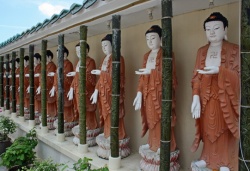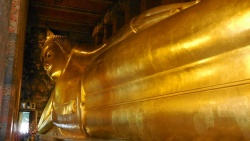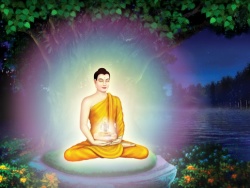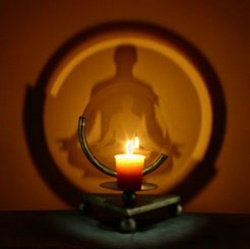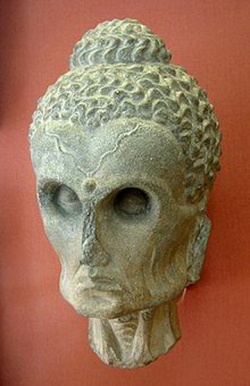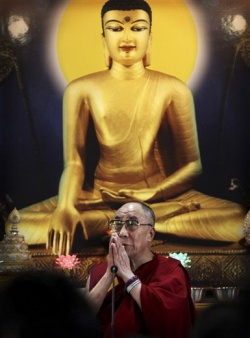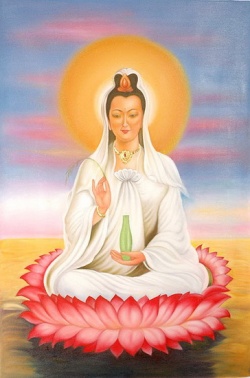Early Buddhist schools
The early Buddhist schools are those schools into which the Buddhist monastic Saṅgha initially split, due originally to differences in Vinaya, and later also due to doctrinal differences and geographical separation of groups of Monks.
The original Saṅgha split into the first early schools (generally believed to be the Sthaviravādins and the Mahāsāṃghikas) a significant number of years after the Death of Gautama Buddha. According to scholar Collett Cox "most scholars would agree that even though the roots of the earliest recognized groups predate Aśoka, their actual separation did not occur until after his Death." Later, these first early schools split into further divisions such as the Sarvāstivādins and the Dharmaguptakas, and ended up numbering, traditionally, about 18 or 20 schools. In fact, there are several overlapping lists of 18 schools preserved in the Buddhist tradition, totalling about twice as many, though some may be alternative names. It is Thought likely that the number is merely conventional.
The schools sometimes split over ideological differences concerning the "real" meaning of teachings in the Suttapiṭaka, and sometimes over disagreement concerning the proper observance of Vinaya. These ideologies became embedded in large works such as the Abhidhammas and commentaries. Comparison of existing versions of the Suttapiṭaka of various sects shows evidence that ideologies from the Abhidhammas sometimes found their way back into the Suttapiṭakas, to support the statements made in those Abhidhammas.
Developments in history
The first Council
Three months after the passing of Buddha, according to scriptures (see Cullavagga XI.1 ff), the first Council was held at Rajagaha by some of his disciples who had attained arahantship (Enlightenment). At this point, Theravāda tradition maintains that no conflict about what The Buddha taught occurred, the teachings were divided into various parts and each was assigned to an elder and his pupils to commit to memory.
The accounts of the Council in the scriptures of the schools differ as to what was actually recited there. Venerable Purāṇa is recorded as having said: "Your reverences, well chanted by the elders are the Dhamma and Vinaya, but in that way that I heard it in the Lord's presence, that I received it in his presence, in that same way will I bear it in Mind." [Vinaya-pitaka: Cullavagga XI:1:11].
Some scholars deny that the first Council actually took place.
The second Council
The second Council did not cause a split in the Saṅgha, as is sometimes claimed. It was strictly about the misbehavior of a group of Monks, who changed their behaviors after the Council.
Period between the second and third councils
The textual sources agree that the first split was between the Sthaviravāda and the Mahāsāṃghika. However, after this initial division, more were to follow. Some modern scholars argue that the first split occurred in the intervening period between the second and third councils, and was probably about monastic discipline. However, only two ancient sources (the Dīpavaṃsa and Bhavya's third list) place the first schism before Aśoka, and none attribute the schism to a dispute on Vinaya practice.
Third Council under Aśoka
Tradition largely holds that Buddhism split into 18 schools, but different sources give different lists of them, and scholars conclude that the number is merely conventional.
Theravādin sources state that, in the 3rd century BCE, a third Council was convened under the patronage of Emperor Aśoka, but no mention of this Council is found in other sources. Some scholars argue that there are certain implausible features of the Theravādin account which imply that the third Council was ahistorical. The remainder consider it a purely Theravāda/Vibhajjavāda Council. It is generally accepted, however, that one or several disputes did occur during Aśoka's reign, involving both doctrinal and disciplinary (Vinaya) matters, although these may have been too informal to be called a "Council". The Sthavira school had, by the time of King Aśoka, divided into three sub-schools, doctrinally speaking, but these did not become separate monastic orders until later.
According to the Theravādin account, this Council was convened primarily for the purpose of establishing an official orthodoxy. At the Council, small groups raised questions about the specifics of the Vinaya and the interpretation of Doctrine. The chairman of the Council, Moggaliputta Tissa, compiled a book, the Kathavatthu, which was meant to refute these arguments. The Council sided with Moggaliputta and his version of Buddhism as orthodox; it was then adopted by Emperor Aśoka as his empire's official Religion. This school of Thought was termed "Vibhajjavāda" (Pāli), literally "thesis of [those who make] a distinction". The distinction involved was as to the existence of Phenomena (dhammas) in the past, future and present. The version of the scriptures that had been established at the third Council, including the Vinaya, Sutta and the ABHIDHAMMA (collectively known as "Tripiṭaka"), was taken to Sri Lanka by Emperor Aśoka's son, the Venerable Mahinda. There it was eventually committed to Writing in the Pāli Language. The Pāli Canon remains the most complete set of surviving Nikāya scriptures, although the greater part of the Sarvāstivādin canon also survives in Chinese translation, some parts exist in Tibetan translations, and some fragments exist in Sanskrit manuscripts, while parts of various canons (sometimes unidentified), exist in Chinese and fragments in other Indian dialects.
Developments during and after the third Council
Whatever might be the Truth behind the Theravādin account, it was around the time of Aśoka that further divisions began to occur within the Buddhist movement and a number of additional schools emerged, including the Sarvāstivāda and the Sammitīya. All of these early schools of Nikāyan Buddhism eventually came to be known collectively as "the eighteen schools" in later sources. Unfortunately, with the exception of the Theravāda, none of these early schools survived beyond the late medieval period by which time several were already long extinct, although a considerable amount of the canonical literature of some of these schools has survived, mainly in Chinese translation. Moreover, the origins of specifically Mahāyāna doctrines may be discerned in the teachings of some of these early schools, in particular in the Mahāsāṅghika and the Sarvāstivāda.
During and after the third Council, elements of the Sthavira group called themselves "Vibhajjavādins". One part of this group was transmitted to Sri Lanka and to certain areas of southern India, such as Vanavasi in the south-west and the Kañci region in the south-east. This group later ceased to refer to themselves specifically as "Vibhajjavādins", but reverted to calling themselves "Theriyas", after the earlier Theras or "Sthaviras". Still later, at some point prior to the Dipavamsa (4th century), the Pāli name "Theravāda" was adopted and has remained in use ever since for this group.
The Pudgalavādins were also known as "Vatsiputrīyas" after their putative founder. Later this group became known as the "Sammitīya" school, after one of its subdivisions. It died out around the 9th or 10th century CE. Nevertheless, during most of the early medieval period, the Sammitīya school was numerically the largest Buddhist group in India, with more followers than all the other schools combined. The Sarvāstivādin school was most prominent in the north-west of India and provided some of the doctrines that would later be adopted by the Mahāyāna. Another group linked to Sarvāstivāda was the Sautrāntika school, which only recognized the authority of the sutras and rejected the Abhidharma transmitted and taught by the Vaibhāṣika wing of Sarvāstivāda. Based on textual considerations, it has been suggested that the Sautrāntikas were actually adherents of Mūlasarvāstivāda. The relation between Sarvāstivāda and Mūlasarvāstivāda, however, is unclear.
Between the 1st century BCE and the 1st century CE, the terms "Mahāyāna" and "Hīnayāna" were first used in Writing, in, for example, the Lotus Sutra.
Mahāyāna members
Although the various early schools of Buddhism are sometimes loosely classified as "Hīnayāna" in modern times, this is not necessarily accurate. According to Jan Nattier, Mahāyāna never referred to a separate sect of Buddhism (Skt. Nikāya), but rather to the set of ideals and doctrines for bodhisattvas. Paul Williams has also noted that the Mahāyāna never had nor ever attempted to have a separate Vinaya or ordination lineage from the early schools of Buddhism, and therefore each bhikṣu or bhikṣuṇī adhering to the Mahāyāna formally belonged to an early school. Membership in these nikāyas, or monastic sects, continues today with the Dharmaguptaka Nikāya in East Asia, and the Mūlasarvāstivāda Nikāya in Tibetan Buddhism. Therefore Mahāyāna was never a separate rival sect of the early schools. Paul Harrison clarifies that while Mahāyānists belonged to a Nikāya, not all members of a Nikāya were Mahāyānists. From Chinese Monks visiting India, we now know that both Mahāyāna and non-Mahāyāna Monks in India often lived in the same Monasteries side by side. Additionally, Isabella Onians notes that Mahāyāna works rarely used the term Hīnayāna, typically using the term Śrāvakayāna instead.
The Chinese Buddhist monk and pilgrim Yijing wrote about relationship between the various "vehicles" and the early Buddhist schools in India. He wrote, "There exist in the West numerous subdivisions of the schools which have different origins, but there are only four principal schools of continuous tradition." These schools are namely the Mahāsāṃghika Nikāya, Sthavira Nikāya, Mūlasarvāstivāda Nikāya, and Saṃmitīya Nikāya. Explaining their doctrinal affiliations, he then writes, "Which of the four schools should be grouped with the Mahāyāna or with the Hīnayāna is not determined." That is to say, there was no simple correspondence between a Buddhist monastic sect, and whether its members learn "Hīnayāna" or "Mahāyāna" teachings.
The Chinese pilgrims
During the first millennium, Monks from China such as Faxian, Xuanzang, and Yijing made pilgrimages to India and wrote accounts of their travels when they returned home. These Chinese travel records constitute extremely valuable sources of Information concerning the state of Buddhism in India during the early medieval period.
By the time the Chinese pilgrims Xuanzang and Yijing visited India, there were five early Buddhist schools that they mentioned far more frequently than others. They commented that the Sarvāstivāda/Mūlasarvāstivāda, Mahāsāṃghika, and Saṃmitīya were the principal early Buddhist schools still extant in India, along with the Sthavira sect. The Dharmaguptakas continued to be found in Gandhāra and Central Asia, Along the Silk Road.
Common biases of research
Bhikkhu Sujato underlines the biases that beset most commonly scholarly research on early Buddhism:
I find myself unable to accept many of the findings of the modern [researcher]s, any more than I could accept the traditions of the schools. It seems to me that much of the modern work, while it has accomplished a great deal, is hampered by the problems that bedevil Buddhist studies in general: uncritical acceptance of textual evidence over archeological findings; bias in favour of either the southern or the northern traditions; reliance on inaccurate or mistaken readings from secondary works and translations; simplistic and unrealistic notions of religious Life in general and monastic Life in particular; lack of understanding of the Vinaya; backreading of later situations into earlier times; and perhaps most importantly, a lack of Appreciation of myth, so that 'historical' Information is divorced from the mythic context that gave it meaning.
The eighteen schools
It is commonly said that there were eighteen schools of Buddhism in this period. What this actually means is more subtle. First, although the word "school" is used, there was not yet an institutional split in the Saṅgha. The Chinese traveler Xuanzang observed even when the Mahāyāna were beginning to emerge out of this era that Monks of different schools would live side by side in dormitories and attend the same lectures. Only the Books that they read were different. Secondly, no historical source can agree what the names of these "eighteen schools" were. The origin of this saying is therefore unclear.
What follows are the lists given by each of the different sources.
According to the Dipavamsa
This list was taken from the Sri Lankan chronicles, Dipavamsa and Mahavamsa.
Sthaviravāda/Vibhajjavāda/Theravāda
Mahīśāsaka - First schism
Sarvāstivāda - Third schism
Kāśyapīya - Forth schism
Sankrantika - Fifth schism
Sautrāntika - Sixth Schism
Dharmaguptaka - Third schism
Vatsīputrīya - First schism
Dharmottarīya - Second schism
Bhadrayānīya - Second schism
Sannāgarika - Second schism
Saṃmitīya - Second schism
Mahāsāṃghika
Gokulika - First schism
Prajñaptivāda - Second schism
Bahuśrutīya - Second schism
Ekavyahārikas - First schism
Caitika - Third schism; According to Dipavamsa, but in the Mahavamsa it is said to have arisen from the Pannati and Bahussutaka)
In addition, the Dipavamsa lists the following six schools without identifying the schools from which they arose:
Hemavatika (Sanskrit: Haimavata)
Rajagiriya
Siddhatthaka
Pubbaseliya
Aparaseliya (Sanskrit: Aparaśaila)
Apararajagirika
According to Vasumitra
This list was taken from Samayabhedo Paracana Cakra, the author of which was Vasumitra a Sarvāstivādin Monk.
Sthaviravāda
Haimavata - First schism; referred to by Sarvāstivādins as "the original Sthavira School", but this school was only influential in the north of India.
Sarvāstivāda - First schism
Vatsīputrīya - Second schism
Dharmottarīya - Third schism
Bhadrayānīya - Third schism
Saṃmitīya - Third schism
Sannāgarika - Third schism
Mahīśāsaka- Forth schism
Dharmaguptaka - Fifth schism
Kāśyapīya - Sixth schism
Sautrāntika - Seventh Schism
Mahāsāṃghika
Ekavyahārikas - First schism
Lokottaravāda - First schism
Gokulika - First schism
Bahuśrutīya - Second schism
Prajñaptivāda - Third schism
Caitika - Forth schism
Apara Śaila - Fourth schism
Uttara Śaila - Fourth schism
According to Vinitadeva
Vinitadeva (c. 645-715) was a Mūlasarvāstivādin Monk.
Sthaviravāda
Jetavaniya
Abhayagirivasin
Mahaviharavasin
Sammatiya
Kaurukullaka
Avantaka
Vatsīputrīya
Sarvastivadin
Mūlasarvāstivādin
Kasyapiya
Mahisasaka
Dharmaguptaka
Bahuśrutīya
Tamrasatiya
Vibhajyavadin
Mahāsāṃghika
Purvasaila
Aparasaila
Haimavata
Lottaravadin
Prajñaptivāda
According to the Sariputrapariprccha
The Sariputrapariprccha is a Mahāsāṃghikan history.
Sthaviravāda
Sarvāstivāda
Mahisasaka
Dharmaguptaka
Suvarsa
Vatsīputrīya
Dharmottarika
Bhadrayaniya
Sammatiya
Sannagarika
Kāśyapīya
Sutravadin
Samkrantika
Mahāsāṃghika
Vyavahara
Lokottaravāda
Gokulika
Bahuśrutīya
Prajñaptivāda
Mahadeva
Caitika
Uttarashaila
Twenty schools according to Mahayana scriptures in Chinese
Sthaviravāda (上座部) was split into 11 sects. These were: Sarvāstivādin (説一切有部), Haimavata (雪山部), Vatsīputrīya (犢子部), Dharmottara (法上部), Bhadrayānīya (賢冑部), Sammitīya (正量部), Channagirika (密林山部), Mahisasaka (化地部), Dharmaguptaka (法蔵部), Kāśyapīya (飲光部), Sautrāntika (経量部).
Sthaviravāda, later Haimavata
Sarvāstivādin
Vatsīputrīya
Dharmottara
Bhadrayānīya
Sammitīya
Channagirika
Mahisasaka
Dharmaguptaka
Kāśyapīya
Sautrāntika
Mahāsāṃghika (大衆部) was split into 9 sects. There were: Ekavyahārika (一説部), Lokottaravādin (説出世部), Gokulika (鶏胤部), Bahuśrutīya (多聞部), Prajñaptivāda (説仮部), Caitika (制多山部), Aparaśaila (西山住部), and Uttaraśaila (北山住部).
Mahāsāṃghika
Ekavyahārika
Caitika
Lokottaravādin
Aparaśaila
Gokulika
Uttaraśaila
Bahuśrutīya
Prajñaptivāda
Hypothetical combined list
Sthaviravāda
Pudgalavāda ('Personalist') (c. 280 BCE)
Vatsīputrīya (during Aśoka) later name: Saṃmitīya
Dharmottarīya
Bhadrayānīya
Sannāgarika
Vibhajjavāda (prior to 240 BCE; during Aśoka)
Theravāda (c. 240 BCE)
Mahīśāsaka (after 232 BCE)
Dharmaguptaka (after 232 BCE)
Sarvāstivāda (c. 237 BCE)
Kāśyapīya (after 232 BCE)
Sautrāntika (between 50 BCE and c. 100 CE)
Mūlasarvāstivāda (3rd and 4th centuries)
Vaibhāṣika
Mahāsāṃghika
Ekavyahārikas (during Aśoka)
Lokottaravāda
Gokulika (during Aśoka)
Bahuśrutīya (late third century BCE)
Prajñaptivāda (late third century BCE)
Caitika (mid-first century BCE)
Apara Śaila
Uttara Śaila
Legacy
The Theravāda School of Sri Lanka, Burma, and Thailand is descended from the Sthaviravādin and (more specifically) the Vibhajjavāda School. It underwent two more changes of name. In the Indian accounts it is sometimes called the "Tāmraparnīya" (translation: Sri Lankan lineage), but there is no indication that this referred to any change in Doctrine or scripture, while it is very obvious that it refers to geographical location. At some point prior to the Dipavamsa (4th century) the name was changed to "Theravāda", probably to reemphasize the relationship to the original "Sthaviravāda", which is the Sanskrit version of the Pāli term "Theravāda".
The Theravāda school is the only remaining school which is exclusively aligned with the philosophic outlook of the early schools. However, significant variation is found between the various Theravādin communities, usually concerning the strictness of practice of Vinaya and the attitude one has towards ABHIDHAMMA. Both these, however, are aspects of the Vibhajjavādin recension of the Tipiṭaka, and the variation between current Theravāda groups is mainly a reflection of accent or emphasis, not content of the Tipiṭaka or the commentaries. The Tipiṭaka of the Theravāda and the main Body of its commentaries are believed to come from (or be heavily influenced by) the Sthaviravādins and especially the subsequent Vibhajjavādins.
The legacies of other early schools are preserved in various Mahāyāna traditions. All of the schools of Tibetan Buddhism use a Mūlasarvāstivāda Vinaya and study the Sarvāstivādin Abhidharma, supplemented with Mahāyāna and Vajrayāna texts. Chinese schools use the Vinaya from the Dharmagupta school, and have versions of those of other schools also. Fragments of the canon of texts from these schools also survive such as the Mahāvastu of the Mahāsānghika School.
